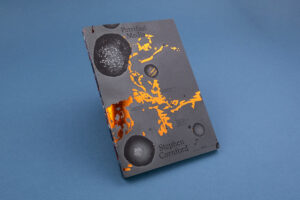YOUR CART
- No products in the cart.
Subtotal:
€ 0

Concept and photography:
Stephen Cornford
Essays:
Siobhan Angus
Jan Zalasiewicz
Stephen Cornford
Text editing:
Patrick Farmer
Design:
Carel Fransen
Lithography:
Mariska Bijl (Wilco Art Books)
Production:
Jos Morree (Fine Books)
Print and binding:
Wilco Art Books (NL)
Supported by:
Centre for Research in The Arts (Oxford Brookes University)
Natural Environment Research Council
What traces of our current civilisation will be left in the geological strata of the planet? What will become of the technological devices that so dominate our lives today in millennia to come? How will these objects be transformed as they travel through deep time?
Drawing on the contemporary debate around the Anthropocene, Stephen Cornford (GB) speculates on the deep future of electronic waste as it sediments into Earth’s stratigraphic record. To travel vertically into the Earth is to look back in time, so to project an object of electronic waste into a potential future in which it petrifies in the lithosphere, Cornford melted his phone in a geological furnace at temperatures up to 1500ºC.
The molten fragments were processed, photographed and analysed using the instruments and experimental processes of petrology. By applying these geological techniques to a hypothetical technofossil, Cornford seeks to materialise a now inevitable scenario in which discarded technologies become part of the planet’s geology, their high concentrations of scarce metals combining to form new minerals that will evidence today’s technological civilisation long after its demise.
In Petrified Media, colourful microscope imagery is combined with the Atlas of Media Metallurgy, in which the images’ elementary composition is analysed, and captions provide background information on the origin of these indispensable metals used in the production of modern technological devices. Three essays by Siobhan Angus (Assistant Professor of Media Studies), Jan Zalasiewicz (Emeritus Professor of Paleobiology), and Cornford himself, reflect on the subject from each writer’s theoretical background.
Stephen Cornford is a media artist concerned with the toxicity of consumer technologies and the role of visual culture in climate change. Much of his recent work has been made in collaboration with scientific researchers, from commercial geophysicists prospecting for technology metals in Europe, to volcanologists studying magma crystallisation with X-rays. His practice often appropriates laboratory processes or imaging instruments. In 2018 he completed a PhD affiliated to the Archaeologies of Media & Technology research group at Winchester School of Art, where he is now Senior Lecturer and programme lead for MA Fine Art.
“The world produces some 50 million tonnes annually, less than a third of which is recycled. And you might think that zillions of selfies float weightlessly through the Cloud, but that requires hardware - batteries, processors, displays, cables, memory banks - made from minerals. From aluminium, silicon and carbon to adolinium, hafnium and lanthanum from the bottom exotic row of the periodic table. Eventually, these will all turn up in layers of earth. Early photographers searched for the right chemicals to capture the light. And photographs of the digital age finally return their minerals. Still cycle. Dust be thou.” (Hans Steketee)